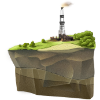- Aboveground crossing
- Accident
- Aeration tank
- Aggressive (corrosive) water
- Air cooler
- Arctic pipelines
- Associated petroleum gas
- Back-stripping analysis
- Barbotage
- Barrage
- Barrel
- Bio-indication
- Bottomhole zone
- Box-and-pin joint (tool joint)
- Carbon black
- Casing string
- Catagenesis of organic substance
- Cavernosity
- Clogging
- Column equipment
- Comprehensive gas treatment unit
- Compressed natural gas filling stations
- Compressing
- Compressor station
- Condensate recovery factor
- Connector
- Core sample
- Correlation
- Corrosion
- Cratering
- Directional drilling
- Distillation-based separation of multi-component fluids
- Diversification
- Drilling
- Drilling (penetration) rate
- Drilling rig
- Dry gas
- Expander
- Extreme anhydrous depression
- Failure in gas industry
- Field development techniques
- Fishing tool
- Flammability limit
- Flare unit
- Fluid
- Fluid dynamics
- Flushing out of well
- Fore deep
- Formation
- Formation pressure
- Formation testing
- Fossil (stratum, reservoir, formation) water
- Free (non-associated) gas
- Free-piston pumping
- Fuel equivalent
- Gas absorption
- Gas adsorption
- Gas cap
- Gas condensate fields
- Gas consumption rate
- Gas deposit water cut
- Gas desorption
- Gas disposition terminal
- Gas distribution network
- Gas distribution plant (GDP)
- Gas engines
- Gas hydrates
- Gas hydrates self-conservation
- Gas interchangeability
- Gas jet ejector
- Gas linepipe
- Gas macrojamming
- Gas processing plant
- Gas separation
- Gas stripping
- Gas supply to consumers
- Gas throttling
- Gas tongue
- Gas transmission system
- Gas trunkline
- Gas-water contact (GWC)
- Gasholder
- Geological exploration risk
- Geological formation
- Geological prospecting
- Gravity exploration
- Greenhouse gases
- Helium
- Horizon
- Hydraulic fracturing
- Hydrocarbons
- Hydrogen index (pH)
- Hydrogenation
- Injection capacity of a well
- Kharasaveyskoye field
- Kovykta field
- Lateral coning
- Lift string
- Line pipe operation center
- Liquefied natural gas
- Lithology
- Logging
- Long-distance gas transmission
- Looping
- Low-temperature separation of gas
- Magnetic prospecting
- Main gas generation phase (MGGP)
- Main oil generation phase (MOGP)
- Medvezhye field
- Membrane technology
- Methane
- Methanol
- Mobile CNG station
- Mofettes
- Natural gas dew point
- Natural gas production
- Natural gas purification
- Natural gas vehicles (NGV)
- Natural pressure gas lift operation
- Natural reservoir
- Octane rating
- Odorant
- Offshore fields exploration
- Oil and gas formation
- Oil and gas reservoir
- Oil rim
- Oil-water contact (OWC)
- Oil/gas blowout
- Orenburg helium refinery
- Packer
- Pad distribution
- Passivization
- Phase
- Phase transitions of hydrocarbon gases
- Pipelaying vessel
- Pipeline accessories (valves and fittings)
- Pipeline route
- Pipeline watercourse
- Pipelines ballasting
- Plugging material (backfill)
- Preventer (blow-out equipment, BOE)
- Producing (pay) horizon
- Prospective resources
- Raw gas
- Reamer
- Regasification
- Repression funnel
- Reserves
- Reserves-to-Production Ratio (RPR)
- Reservoir depression
- Reservoir energy
- Reservoir gas of condensate accumulations
- Reservoir impermeable seal
- Reservoir temperature
- Retrograde phenomena
- Riser string
- Rock gas saturation
- Satellite soils monitoring
- Secondary (enhanced) recovery methods
- Seismic exploration
- Skin-effect
- Sorption
- Spot trading
- Stabilized condensate
- Standard conditions
- Stray currents
- Subsurface use licensing
- Swivel
- Synthesis gas
- Take-or-pay
- Tubing string
- Unified Gas Supply System
- Unstabilized condensate
- Viscosity
- Well
- Well cementing
- Well deviation
- Well recompletion
- Well stock
- Well suspension
- Wellhead pressure
- Western Siberia oil and gas bearing province
- Working gas
- Zapolyarnoye field
During exploration as well as for production of liquid and gaseous underground resources in the Earth crust rock mass, small diameter and considerably long cylindrical holes are made, which are called drilling wells. Drilling wells are made both from the surface and subsurface tunnels. They may have various dimensional forms (linear, spiral) and directions (upward, downward, horizontal, inclined).
Test wells are used to study the geological and hydrological conditions of major regions, for defining a common patterns set of occurrence of deposits with features favorable for oil and gas accumulation with the purpose to select the exploration areas with the best potentials.
Parametric (appraisal) wells are used to study deep geology aspects, to compare hydrocarbons potential of possible oil and gas accumulation zones. Such wells help to identify the areas with the highest potential for detailed geological studies and to get the necessary data about geological and geophysical features of the section to specify the results of seismic and other geophysical studies.
Structural well (core hole) is drilled with the purpose to identify the most promising areas and to prepare them for prospecting and exploratory drilling. Based on data obtained during such drilling mode of occurrence, lithological composition and stratigraphical position of the studied reservoirs are defined and then used to develop geological profiles of the given area.
Prospecting wells (“wildcats”) are drilled in the area prepared through geological exploration work with the purpose of discovering new fields and identifying new accumulations in previously discovered fields.
Exploratory wells are drilled in the areas with already identified commercial HC potential with the purpose of preparing commercial oil and gas reserves and collecting initial data for reservoir development planning.
Producing wells are used for oil and gas fields and deposits development. There are several categories of producing wells:
- Producer – an operational facility providing for transporting gas from reservoir to the surface at the expense of its natural formation energy.
- Test wells are used for evaluation of producing reservoirs. Injection wells are necessary for pumping water, gas, air and other agents into producing horizons.
- Monitoring and pressure-observation wells are used for monitoring changes of reservoir pressure, temperature, for gas and water sampling, for moving of gas-water and oil-water contacts, and for geophysical studies. Physical wells and inspection wells also belong to monitoring wells; they are used for producing reservoir completion when building underground gas storage facilities.
- Wells for thermal bed stimulation are used for developing high-viscosity oil fields.
Special well is drilled to collect produced water (injection well), to liquidate open oil and gas flows; exploration and production of process water. Back-up well for gas off-take from UGS facility during peak demand and for replacing producing well also belongs to special well.


